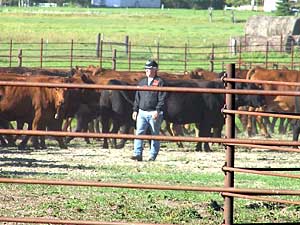|
Audio
Photos
More from MPR
Resources
|
 |
| Roger Skime walks among his cattle before they're loaded on trucks to be taken to a slaughterhouse. (MPR Photo/Dan Gunderson) |
Skime, Minn. — Roger Skime spent 20 years building his beef herd to what experts say is one of the finest in the state. He has tears in his eyes as he helps load the 600 cows and their calves on a caravan of trucks, bound for a slaughter plant.
"I'm kind of proud of every one that raised a bigger and better calf every year. That's the the reward you get out of being in the business," says Skime. "She's going to look pretty sad around here at the end of the week, when all the trucks have left and there's nothing left but fences and buildings."
Until this spring, there had not been a documented case of bovine tuberculosis in Minnesota since 1971. Until the early 1970s, every cattle herd got a regular TB test, but the screening was stopped when officials decided the disease had been eradicated in Minnesota.
This spring one of Roger Skime's cattle showed evidence of TB when it was slaughtered at a Wisconsin meatpacking plant. Subsequent testing found several other cattle on his ranch infected with bovine tuberculosis. A screening test can identify infected live animals.
Bovine tuberculosis has also been found in several neighboring herds, but it's still not clear where the disease originated. It can be spread when animals touch noses, or when mucous from an infected animal gets on feed which other cattle eat.
Terry Bolding, a veterinarian with the Minnesota Board of Animal Health, says there's limited health risk for people. It's possible for people to get the disease, but they'd have to drink unpasteurized milk from an infected cow, or get sneezed on by an infected animal.
The problem is there's no treatment for cattle with bovine TB. So the only way to stop the spread of the disease is to kill herds with infected cattle. The U.S. Department of Agriculture pays the rancher for the cattle. Officials say it's safe to eat the meat from cattle infected with bovine tuberculosis.
Terry Bolding says an aggressive approach is needed because the stakes are high for the Minnesota cattle industry.
"Minnesota is now considered a tuberculosis-free state, which gives us some kind of neat privileges. We can move our cattle to most other states without a TB test. The prices, therefore, are a little bit higher and the cost to the producer is lower," says Bolding. "If we lose our free status, other states may elect to not take our animals at all. If we keep finding more and more cases and we find it in wildlife, that would bode bad."
If the disease can't be contained, Minnesota could become one of a handful of states to lose federal certification as free of bovine TB. The USDA says Michigan, Texas and New Mexico are other states that have ongoing problems with bovine tuberculosis, and have restrictions placed on cattle shipped out of state.
There is no evidence yet that whitetail deer are infected with bovine TB, but Terry Bolding says there's little doubt in his mind deer have the disease. It's admittedly speculation at this point, but he thinks deer may have helped spread TB from one cattle herd to another.
Lin Giannonatti helped run the Skime ranch for 10 years, and now has his own small operation a few miles away. He's waiting for results of TB testing on his cattle.
"When this whole thing started I was completely against the fact that it was in the deer. But the evidence is pointing the other direction now," says Giannonatti. "The deer are in the cattle feed. They cough and sneeze in it. Then you pick up that contaminated feed and feed it to your cows."
"There's way too many deer. Anybody will tell you," Giannonatti adds. "I don't know what they figure a healthy deer herd is. But you go take a drive around two sections over here, you can probably count 300 to 500 deer, right now. And that's around two sections of land.Two square miles."
Giannonatti says raising cattle will be more difficult if TB is found in wild deer, because ranchers will need to find ways to keep deer away from cattle and cattle feed.
It's not clear what action the state would take if TB is found in wild deer. Experts say when there's a large population of deer in a small area, it's difficult to control the spread of the disease.
There's no documented history of bovine tuberculosis in Minnesota deer. But it's already a problem in deer herds in Manitoba and Michigan.
The Minnesota Department of Natural Resources plans to test for TB during this fall's hunting season. They will collect lymph nodes from about 500 deer killed by hunters in Roseau County.
Rancher Roger Skime will wait to see what they find before deciding if he will start building a new cattle herd.
"If there's disease in the deer I don't know how we can repopulate," says Skime. "We'll just reinfect a new herd if that's the case. I gotta know we won't go through this again. This is too much heartache to go through again."
The Minnesota Board of Animal Health will be testing other cattle herds this fall, trying to determine how far the bovine tuberculosis has spread.






